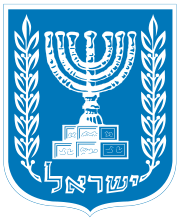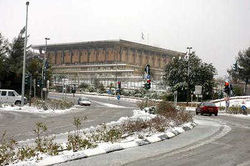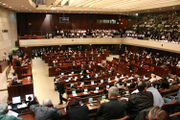Knesset
| Knesset כנסת الكنيست |
|
|---|---|
 |
|
| Type | |
| Type | Unicameral |
| Leadership | |
| Speaker | Reuven Rivlin, Likud since March 30, 2009 |
| Structure | |
| Members | 120 |
| Meeting place | |
| Knesset, Jerusalem, Israel | |
| Website | |
| www.knesset.gov.il | |
The Knesset (Hebrew: כנסת, ˈknɛsɛt; lit. gathering[1] or assembly; Arabic: الكنيست) is the legislature of Israel, located in Givat Ram, Jerusalem.
Contents |
Operation of the Knesset
The legislative branch of the Israeli government, the Knesset enacts laws, elects the president and prime minister (although he or she is ceremonially appointed by the President), supervises the work of the government, reserves the power to remove the President of the State and the State Comptroller from office and to dissolve itself and call new elections.
The Knesset first convened on 14 February 1949, following the 20 January elections, succeeding the Assembly of Representatives that had functioned as the Jewish community's parliament during the Mandate era. The 120 members of the Knesset (MKs) are elected to four-year terms, but early election are often called. They are elected in secret ballot by Israeli citizens over 18 years old. The Government of Israel must be approved by a majority vote of the Knesset.
The Knesset has de jure parliamentary supremacy and can pass any law by a simple majority, even one that might arguably conflict with the Basic Laws of Israel, unless the basic law includes specific conditions for its modification; in accordance with a plan adopted in 1950, the Basic Laws have themselves been adopted (and occasionally amended) over the course of the years by the Knesset, acting in its capacity as a Constituent Assembly.[2] In practice, the Knesset's ability to legislate has often been limited in consequence of the system of low-threshold party list proportional representation, which has tended to produce governments formed of unstable coalitions of multiple factions. The low vote threshold for entry into parliament, as well as the need for these small-party seats to form coalition governments, causes the political spectrum to be highly fragmented, with small parties exercising disproportionate coalition power, relative to their electoral strength. This makes it very difficult for any party to gain a working majority in the Knesset and thus the government is generally formed on the basis of a coalition. Elections are often held earlier than scheduled after a motion of no-confidence, due to difficulties in holding coalitions together. The average life span of an Israeli government is 25 months. Over the years, the peace process, the role of religion in the state, and political scandals have caused coalitions to break apart or produced early elections.
In addition, to the absence of a formal constitution, and with no Basic Law thus far being adopted, which formally grants a power of judicial review to the judiciary, the Supreme Court of Israel has in recent years asserted its authority, when sitting as the High Court of Justice, to invalidate provisions of Knesset laws it has found to be inconsistent with a Basic Law.[2][3] The Knesset is guarded by the Knesset Guard.
Size
The size of the Knesset, currently at 120 members, has often been a source of cause for proposed reforms. In 1996, then-Justice Minister Yossi Beilin[4] backed the ultimately-unsuccessful institution of the so-called "Norwegian law", which would require appointed members of the cabinet to resign their seats in the Knesset and allow other members of their parties to take their positions while they serve in the cabinet; this would have resulted in more active members of the legislature being present in regular sessions and committee meetings. This proposed law has also been favored by other politicians, including Yitzhak Levy (who has backed the raising of total seats to 150[5]) and current prime minister Benjamin Netanyahu[6].
History

The Knesset sits on a hilltop in western Jerusalem in a district known as Sheikh Badr before the 1948 Arab-Israeli War and now known as Givat Ram. It was financed by James A. de Rothschild as a gift to the State of Israel. It was built on land leased from the Greek Orthodox Patriarchate of Jerusalem.[7]


Before the construction of its permanent home, the Knesset met in the Jewish Agency building in Jerusalem, the Kessem Cinema building in Tel Aviv and the Froumine building in Jerusalem.[8]
The term "Knesset" is derived from the ancient Great Assembly or Great Synagogue (Hebrew: כְּנֶסֶת הַגְּדוֹלָה) which according to Jewish tradition was an assembly of 120 scribes, sages, and prophets, in the period from the end of the Biblical prophets to the time of the development of Rabbinic Judaism - about two centuries ending c. 70 CE. There is, however, no organizational continuity and - aside from the number of members - little similarity, as the ancient Knesset was an essentially religious, completely unelected body.
Knesset Assemblies
Each Knesset session is known by its election number. Thus the Knesset elected by Israel's first election in 1949 is known as the First Knesset. The current Knesset, elected in 2009 is the Eighteenth Knesset.
|
|
|
Current Knesset
The composition of the current Knesset was determined by the 2009 election. At present there are 18 parties represented in the Knesset on 12 lists (some parties run for election together on joint lists). Though it has not yet happened in the current session, in every Knesset to date (save the remarkably stable Third) parties have split up during the Knesset's term, leading to the creation of new parties or resulting in MKs sitting as independents.
The parties in the current Knesset are shown in the table below.
| Party | Seats |
|---|---|
| Kadima | 28 |
| Likud | 27 |
| Yisrael Beiteinu | 15 |
| Labor | 13 |
| Shas | 11 |
| United Torah Judaism1 | 5 |
| National Union2 | 4 |
| Hadash | 4 |
| United Arab List-Ta'al | 4 |
| The Jewish Home | 3 |
| New Movement-Meretz | 3 |
| Balad | 3 |
| Total | 120 |
- ^ United Torah Judaism is an alliance of Agudat Israel and Degel HaTorah.
- ^ The National Union is an alliance of Eretz Yisrael Shelanu, Hatikva, Moledet and Tkuma.
February 2009 elections
The Knesset was reconstituted following elections in February 2009, which resulted 28 seats for Kadima, 27 for Likud, 15 for Yisrael Beiteinu, 13 for Labor, 12 for three small religious parties (5 for United Torah Judaism, 4 for National Union and 3 for Jewish Home), 11 for Shas, 7 for two Arab parties (4 for Ta'al, 3 for Balad), 4 for the non-Zionist Hadash, and 3 for the left-wing Jewish party Meretz.
Although the Central Elections Committee attempted to ban the participation of the two Arab parties United Arab List-Ta'al and Balad for alleged disloyalty to the state and support of Israel's enemies, the ban was, by a vote of 8 to 1, overturned by the Israeli Supreme Court, allowing the parties to participate.[9][10]
Timeline
- February 14, 1949: First meeting of the Constituent Assembly, Jewish Agency, Jerusalem
- March 8, 1949-December 14, 1949: Kessem Cinema in Tel Aviv (Migdal HaOpera is situated there today)
- December 26, 1949-March 8, 1950: Jewish Agency, Jerusalem
- March 13, 1950: Froumine Building, King George Street, Jerusalem.
- 1950-1955: Israeli government holds architectural competitions for the permanent Knesset building
- 1955: Government approves plans to build the Knesset in its current location
- 1957: James A. de Rothschild informs Prime Minister David Ben-Gurion of his desire to finance the construction of the building
- October 14, 1958: Cornerstone-laying for new Knesset building
- August 31, 1966: Dedication of new building (in the days of the Sixth Knesset)
- 1981: Construction of new wing begins
- 1992: New wing opens
- 2005: Construction of another new wing
Frequent tours
The Knesset holds morning tours in Hebrew, English, French, Spanish, Arabic, German and Russian, on Sunday and Thursday and there are also live session viewing times on Monday, Tuesday and Wednesday mornings.[11]
See also
- Elections in Israel
- List of Knesset members
- List of Knesset speakers
- List of Likud Knesset Members
- Arab Knesset members
- Knesset Guard
References
- ↑ The Oxford Dictionary of English, Oxford University Press, 2005
- ↑ 2.0 2.1 "Basic Laws - Introduction". Knesset. http://www.knesset.gov.il/description/eng/eng_mimshal_yesod.htm. Retrieved 2010-03-05.
- ↑ Models of Judicial Review Constitution for Israel
- ↑ Cabinet likely to approve 'Norwegian law' on Sunday, Jerusalem Post
- ↑ Yitzhak Levy proposes raising number of Knesset members to 150., Jerusalem Post
- ↑ Netanyahu considering forcing ministers to vacate Knesset seats, Haaretz
- ↑ Defacement in Jerusalem monastery threatens diplomatic crisis Haaretz, 8 October 2006
- ↑ http://www.knesset.gov.il/lexicon/eng/beit_fromin_eng.htm
- ↑ Shahar Ilan, Roni Singer-Heruti (13 January 2009). "Israel bans Arab parties from running in upcoming elections". Haaretz. http://www.haaretz.com/hasen/spages/1054867.html.
- ↑ "Poll ban on Arab Israelis lifted". BBC News. January 9, 2003. http://news.bbc.co.uk/2/hi/middle_east/2641227.stm. Retrieved March 27, 2010.
- ↑ Knesset Times to Visit
External links
|
||||||||
|
|||||||
|
||||||||||||||